Effect of Titanium and Molybdenum Cover on the Surface Restructuration of Diamond Single Crystal during Annealing
Abstract
1. Introduction
2. Materials and Methods
3. Results
3.1. Morphology of Annealed Diamond Surface under Mo and Ti Layers
3.2. Surface States of Diamonds
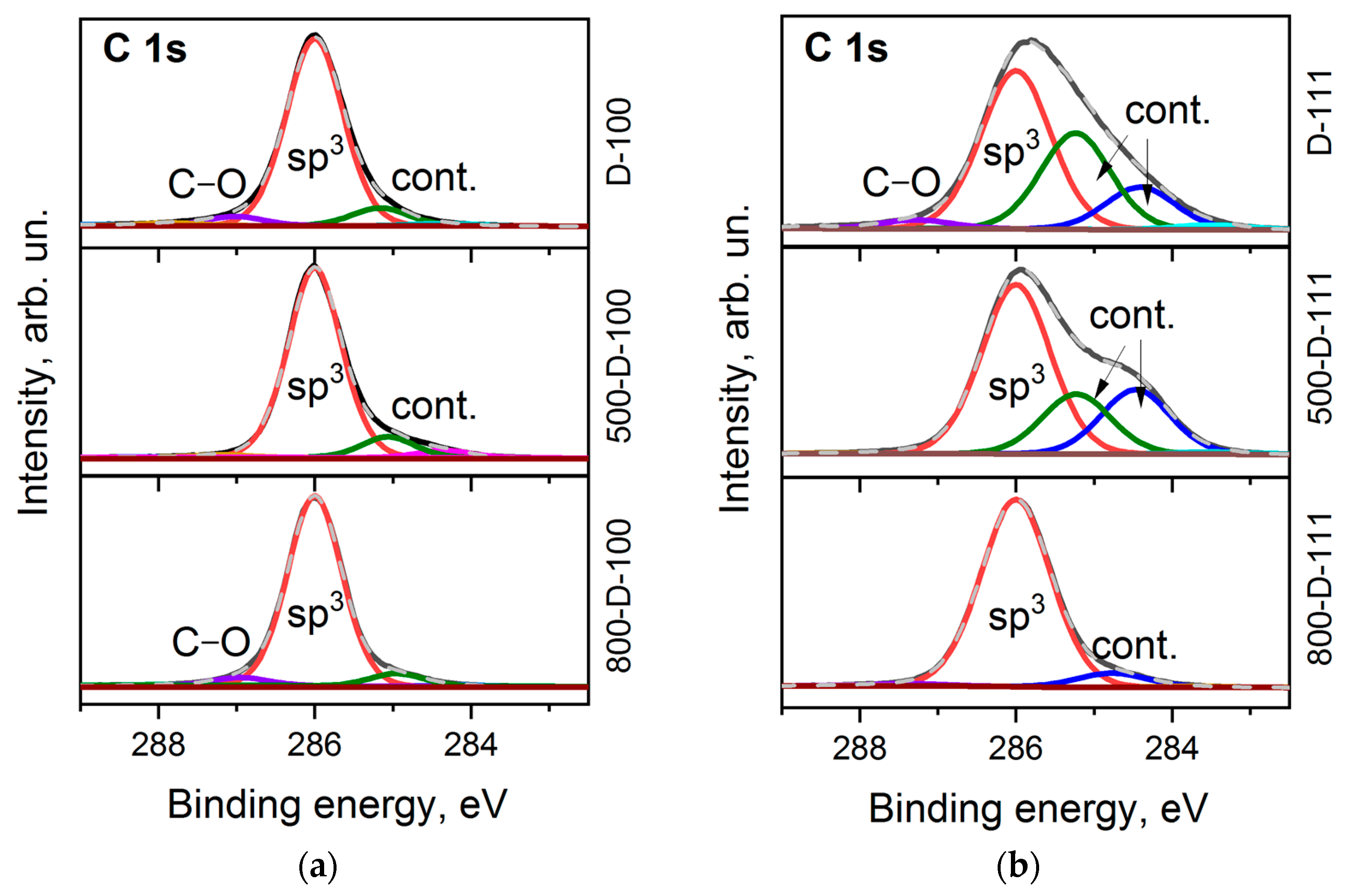
3.3. Ti-Coated Diamond Surfaces
3.4. Mo-Coated Diamond Surfaces
4. Discussion
5. Conclusions
Supplementary Materials
Author Contributions
Funding
Institutional Review Board Statement
Informed Consent Statement
Data Availability Statement
Acknowledgments
Conflicts of Interest
References
- Wort, C.J.; Balmer, R.S. Diamond as an electronic material. Mater. Today 2008, 11, 22–28. [Google Scholar] [CrossRef]
- Willander, M.; Friesel, M.; Wahab, Q.-U.; Straumal, B. Silicon carbide and diamond for high temperature device applications. J. Mater. Sci. Mater. Electron. 2006, 17, 1–25. [Google Scholar] [CrossRef]
- Vavilov, V.S. The properties of natural and synthetic diamond. Physics-Uspekhi 1993, 36, 1083–1084. [Google Scholar] [CrossRef]
- Araujo, D.; Suzuki, M.; Lloret, F.; Alba, G.; Villar, P. Diamond for Electronics: Materials, Processing and Devices. Materials 2021, 14, 7081. [Google Scholar] [CrossRef] [PubMed]
- Crawford, K.G.; Maini, I.; Macdonald, D.A.; Moran, D.A. Surface transfer doping of diamond: A review. Prog. Surf. Sci. 2021, 96, 100613. [Google Scholar] [CrossRef]
- Su, K.; Ren, Z.; Zhang, J.; Liu, L.; Zhang, J.; Zhang, Y.; He, Q.; Zhang, C.; Ouyang, X.; Hao, Y. High performance hydrogen/oxygen terminated CVD single crystal diamond radiation detector. Appl. Phys. Lett. 2020, 116, 092104. [Google Scholar] [CrossRef]
- Fedoseeva, Y.V.; Bulusheva, L.G.; Okotrub, A.V.; Kanygin, M.A.; Gorodetskiy, D.V.; Asanov, I.P.; Vyalikh, D.V.; Puzyr, A.P.; Bondar, V.S. Field emission luminescence of nano diamonds deposited on the aligned carbon nanotube array. Sci. Rep. 2015, 5, 9379. [Google Scholar] [CrossRef]
- Sun, Y.; Sun, M.; Xie, D. Graphene Electronic Devices. In Graphene, 1st ed.; Zhu, H., Xu, Z., Xie, D., Fang, Y., Eds.; Elsevier: New York, NY, USA, 2018; pp. 103–155. [Google Scholar]
- Matsumoto, T.; Kato, H.; Tokuda, N.; Makino, T.; Ogura, M.; Takeuchi, D.; Okushi, H.; Yamasaki, S. Reduction of n-type diamond contact resistance by graphite electrode. Phys. Status Solidi (RRL)–Rapid Res. Lett. 2013, 8, 137–140. [Google Scholar] [CrossRef]
- De Feudis, M.; Caricato, A.P.; Taurino, A.; Ossi, P.M.; Castiglioni, C.; Brambilla, L.; Maruccio, G.; Monteduro, A.G.; Broitman, E.; Chiodini, G.; et al. Diamond graphitization by laser-writing for all-carbon detector applications. Diam. Relat. Mater. 2017, 75, 25–33. [Google Scholar] [CrossRef]
- Alemanno, E.; Martino, M.; Caricato, A.; Corrado, M.; Pinto, C.; Spagnolo, S.; Chiodini, G.; Perrino, R.; Fiore, G. Laser induced nano-graphite electrical contacts on synthetic polycrystalline CVD diamond for nuclear radiation detection. Diam. Relat. Mater. 2013, 38, 32–35. [Google Scholar] [CrossRef]
- De Feudis, M.; Caricato, A.P.; Chiodini, G.; Martino, M.; Maruccio, G.; Monteduro, A.G.; Ossi, P.M.; Perrino, R.; Spagnolo, S. Diamond detectors with electrodes graphitized by means of laser. II Nuovo Cim. C 2016, 39, 1–4. [Google Scholar]
- Tokuda, N.; Fukui, M.; Makino, T.; Takeuchi, D.; Yamsaki, S.; Inokuma, T. Formation of Graphene-on-Diamond Structure by Graphitization of Atomically Flat Diamond (111) Surface. Jpn. J. Appl. Phys. 2013, 52, 110121. [Google Scholar] [CrossRef]
- Yan, X.; Wei, J.; Guo, J.; Hua, C.; Liu, J.; Chen, L.; Hei, L.; Li, C. Mechanism of graphitization and optical degradation of CVD diamond films by rapid heating treatment. Diam. Relat. Mater. 2017, 73, 39–46. [Google Scholar] [CrossRef]
- Kuznetsov, V.L.; Zilberberg, I.L.; Butenko, Y.V.; Chuvilin, A.L.; Segall, B. Theoretical study of the formation of closed curved graphite-like structures during annealing of diamond surface. J. Appl. Phys. 1999, 86, 863–870. [Google Scholar] [CrossRef]
- Bai, Q.; Wang, Z.; Guo, Y.; Chen, J.; Shang, Y. Graphitization Behavior of Single Crystal Diamond for the Application in Nano-Metric Cutting. Curr. Nanosci. 2018, 14, 377–383. [Google Scholar] [CrossRef]
- Berman, D.; Deshmukh, S.A.; Narayanan, B.; Sankaranarayanan, S.K.R.S.; Yan, Z.; Balandin, A.A.; Zinovev, A.; Rosenmann, D.; Sumant, A.V. Metal-induced rapid transformation of diamond into single and multilayer graphene on wafer scale. Nat. Commun. 2016, 7, 12099. [Google Scholar] [CrossRef]
- García, J.M.; He, R.; Jiang, M.P.; Kim, P.; Pfeiffer, L.N.; Pinczuk, A. Multilayer graphene grown by precipitation upon cooling of nickel on diamond. Carbon 2011, 49, 1006–1012. [Google Scholar] [CrossRef]
- Cooil, S.P.; Song, F.; Williams, G.T.; Roberts, O.R.; Langstaff, D.P.; Jørgensen, B.; Høydalsvik, K.; Breiby, D.W.; Wahlström, E.; Evans, D.A.; et al. Iron-mediated growth of epitaxial graphene on SiC and diamond. Carbon 2012, 50, 5099–5105. [Google Scholar] [CrossRef]
- Kanada, S.; Nagai, M.; Ito, S.; Matsumoto, T.; Ogura, M.; Takeuchi, D.; Yamasaki, S.; Inokuma, T.; Tokuda, N. Fabrication of graphene on atomically flat diamond (111) surfaces using nickel as a catalyst. Diam. Relat. Mater. 2017, 75, 105–109. [Google Scholar] [CrossRef]
- Tulić, S.; Waitz, T.; Čaplovičová, M.; Habler, G.; Vretenár, V.; Susi, T.; Skákalová, V. Catalytic graphitization of single-crystal diamond. Carbon 2021, 185, 300–313. [Google Scholar] [CrossRef]
- Okotrub, A.V.; Gorodetskiy, D.V.; Palyanov, Y.N.; Smirnov, D.A.; Bulusheva, L.G. Iron-catalyzed growth of vertical graphitic layers on the (100) face of single-crystal diamond. J. Phys. Chem. C 2023, accepted. [Google Scholar] [CrossRef]
- Leroy, W.P.; Detavernier, C.; Van Meirhaeghe, R.L.; Kellock, A.J.; Lavoie, C. Solid-state formation of titanium carbide and molybdenum carbide as contacts for carbon-containing semiconductors. J. Appl. Phys. 2006, 99, 063704. [Google Scholar] [CrossRef]
- Ichibha, T.; Hongo, K.; Motochi, I.; Makau, N.; Amolo, G.; Maezono, R. Adhesion of electrodes on diamond (111) surface: A DFT study. Diam. Relat. Mater. 2018, 81, 168–175. [Google Scholar] [CrossRef]
- Guo, L.; Chen, G. High-quality diamond film deposition on a titanium substrate using the hot-filament chemical vapor deposition method. Diam. Relat. Mater. 2007, 16, 1530–1540. [Google Scholar] [CrossRef]
- Chen, L.-J.; Tai, N.-H.; Lee, C.-Y.; Lin, I.-N. Effects of pretreatment processes on improving the formation of ultrananocrystalline diamond. J. Appl. Phys. 2007, 101, 064308. [Google Scholar] [CrossRef]
- Chakk, Y.; Brener, R.; Hoffman, A. Enhancement of diamond nucleation by ultrasonic substrate abrasion with a mixture of metal and diamond particles. Appl. Phys. Lett. 1995, 66, 2819–2821. [Google Scholar] [CrossRef]
- Reinke, P.; Oelhafen, P. Bias-enhanced nucleation of diamond on molybdenum: A photoelectron spectroscopy study of the initial stages of the growth process. J. Appl. Phys. 1998, 84, 2612–2617. [Google Scholar] [CrossRef]
- Yoon, S.F.; Huang, Q.F.; Rusli; Yang, H.; Ahn, J.; Zhang, Q.; Shi, X. Characteristic of molybdenum-containing aC: H films deposited using electron cyclotron resonance CVD. Int. J. Mod. Phys. B 2000, 14, 309–314. [Google Scholar] [CrossRef]
- Faggio, G.; Donato, M.G.; Lagomarsino, S.; Messina, G.; Santangelo, S.; Sciortino, S. Nucleation Process of CVD Diamond on Molybdenum Substrates. In Carbon; Topics in Applied Physics; Messina, G., Santangelo, S., Eds.; Springer: Berlin/Heidelberg, Germany, 2006; pp. 329–343. [Google Scholar]
- Fedoseeva, Y.V.; Gorodetskiy, D.V.; Makarova, A.A.; Yudin, I.B.; Timoshenko, N.I.; Plotnikov, M.Y.; Emelyanov, A.A.; Rebrov, A.K.; Okotrub, A.V. Influence of the temperature of molybdenum substrates on the structure of diamond coatings obtained by chemical vapor deposition from a high-speed microwave plasma jet. J. Struct. Chem. 2021, 62, 153–162. [Google Scholar] [CrossRef]
- Dwivedi, N.; Kumar, S.; Malik, H.K. Nanostructured Titanium/Diamond-Like Carbon Multilayer Films: Deposition, Characterization, and Applications. ACS Appl. Mater. Interfaces 2011, 3, 4268–4278. [Google Scholar] [CrossRef]
- Kimura, T.; Kamata, H.; Nakao, S.; Azuma, K. Preparation of Titanium-Doped Diamond-Like Carbon Films With Electrical Conductivity Using High Power Pulsed Magnetron Sputtering System With Bipolar Pulse Voltage Source for Substrate. IEEE Trans. Plasma Sci. 2016, 44, 3083–3090. [Google Scholar] [CrossRef]
- Novikov, N.; Voronkin, M.; Bondar, I. Interaction of diamond with molybdenum during ion plasma deposition. Diam. Relat. Mater. 1994, 3, 61–65. [Google Scholar] [CrossRef]
- Fogarty, F.; Fox, N.A.; May, P.W. Experimental studies of electron affinity and work function from titanium on oxidised diamond (100) surfaces. Funct. Diam. 2022, 2, 103–111. [Google Scholar] [CrossRef]
- Tachibana, T.; Williams, B.E.; Glass, J.T. Correlation of the electrical properties of metal contacts on diamond films with the chemical nature of the metal-diamond interface. II. Titanium contacts: A carbide-forming metal. Phys. Rev. B 1992, 45, 11975. [Google Scholar] [CrossRef] [PubMed]
- Kono, S.; Teraji, T.; Kodama, H.; Ichikawa, K.; Ohnishi, S.; Sawabe, A. Direct determination of the barrier height of Ti-based ohmic contact on p-type diamond (001). Diam. Relat. Mater. 2015, 60, 117–122. [Google Scholar] [CrossRef]
- Nakanishi, J.; Otsuki, A.; Oku, T.; Ishiwata, O.; Murakami, M. Formation of ohmic contacts to p-type diamond using carbide forming metals. J. Appl. Phys. 1994, 76, 2293–2298. [Google Scholar] [CrossRef]
- Lu, Y.; Huang, G.; Wang, S.; Mi, C.; Wei, S.; Tian, F.; Li, W.; Cao, H.; Cheng, Y. A review on diamond-like carbon films grown by pulsed laser deposition. Appl. Surf. Sci. 2020, 541, 148573. [Google Scholar] [CrossRef]
- Mikhailov, S.; Ariosa, D.; Weber, J.; Baer, Y.; Hänni, W.; Tang, X.-M.; Alers, P. The behaviour of the molybdenum-CVD diamond interface at high temperature. Diam. Relat. Mater. 1995, 4, 1137–1141. [Google Scholar] [CrossRef]
- Palyanov, Y.N.; Borzdov, Y.M.; Khokhryakov, A.F.; Kupriyanov, I.N.; Sokol, A.G. Effect of nitrogen impurity on diamond crystal growth processes. Cryst. Growth Des. 2010, 10, 3169–3175. [Google Scholar] [CrossRef]
- Poirier, D.M.; Weaver, J.H. Carbon (as graphite, buckminsterfullerene, and diamond) by XPS. Surf. Sci. Spectra 1993, 2, 232–241. [Google Scholar] [CrossRef]
- Dychalska, A.; Koczorowski, W.; Trzcinski, M.; Mosińska, L.; Szybowicz, M. The Effect of Surface Treatment on Structural Properties of CVD Diamond Layers with Different Grain Sizes Studied by Raman Spectroscopy. Materials 2021, 14, 1301. [Google Scholar] [CrossRef] [PubMed]
- Thomas, E.L.; Nelson, G.W.; Mandal, S.; Foord, J.S.; Williams, O.A. Chemical mechanical polishing of thin film diamond. Carbon 2014, 68, 473–479. [Google Scholar] [CrossRef]
- Alba, G.; Villar, M.P.; Alcántara, R.; Navas, J.; Araujo, D. Surface States of (100) O-Terminated Diamond: Towards Other 1 × 1:O Reconstruction Models. Nanomaterials 2020, 10, 1193. [Google Scholar] [CrossRef] [PubMed]
- Fedoseeva, Y.; Gorodetskiy, D.; Baskakova, K.; Asanov, I.; Bulusheva, L.; Makarova, A.; Yudin, I.; Plotnikov, M.; Emelyanov, A.; Rebrov, A.; et al. Structure of Diamond Films Grown Using High-Speed Flow of a Thermally Activated CH4-H2 Gas Mixture. Materials 2020, 13, 219. [Google Scholar] [CrossRef] [PubMed]
- Näslund, L.; Persson, P.O.; Rosen, J. X-ray Photoelectron Spectroscopy of Ti3AlC2, Ti3C2Tz, and TiC Provides Evidence for the Electrostatic Interaction between Laminated Layers in MAX-Phase Materials. J. Phys. Chem. C 2020, 124, 27732–27742. [Google Scholar] [CrossRef]
- Liu, G.; Jaegermann, W.; He, J.; Sundström, V.; Sun, L. XPS and UPS characterization of the TiO2/ZnPcGly heterointerface: Alignment of energy levels. J. Phys. Chem. B 2002, 106, 5814–5819. [Google Scholar] [CrossRef]
- Schier, V.; Michel, H.J.; Halbritter, J. ARXPS-analysis of sputtered TiC, SiC and Ti0.5Si0.5C layers. Fresenius’ J. Anal. Chem. 1993, 346, 227–232. [Google Scholar] [CrossRef]
- Larina, L.L.; Omelianovych, O.; Dao, V.-D.; Pyo, K.; Lee, D.; Choi, H.-S. Energy band alignment at the heterointerface between a nanostructured TiO2 layer and Au22(SG)18 clusters: Relevance to metal-cluster-sensitized solar cells. Nanoscale 2020, 13, 175–184. [Google Scholar] [CrossRef]
- Lin, J.; Moore, J.J.; Mishra, B.; Pinkas, M.; Sproul, W.D. Syntheses and characterization of TiC/a:C composite coatings using pulsed closed field unbalanced magnetron sputtering (P-CFUBMS). Thin Solid Film. 2008, 517, 1131–1135. [Google Scholar] [CrossRef]
- Freedy, K.M.; Beechem, T.E.; Litwin, P.M.; Sales, M.G.; Huang, M.; Ruoff, R.S.; McDonnell, S.J. Unraveling Chemical Interactions between Titanium and Graphene for Electrical Contact Applications. ACS Appl. Nano Mater. 2018, 1, 4828–4835. [Google Scholar] [CrossRef]
- Oshikawa, K.; Nagai, M.; Omi, S. Characterization of Molybdenum Carbides for Methane Reforming by TPR, XRD, and XPS. J. Phys. Chem. B 2001, 105, 9124–9131. [Google Scholar] [CrossRef]
- Murugappan, K.; Anderson, E.M.; Teschner, D.; Jones, T.E.; Skorupska, K.; Román-Leshkov, Y. Operando NAP-XPS unveils differences in MoO3 and Mo2C during hydrodeoxygenation. Nat. Catal. 2018, 1, 960–967. [Google Scholar] [CrossRef]
- Song, Z.; Cai, T.; Chang, Z.; Liu, G.; Rodriguez, J.A.; Hrbek, J. Molecular Level Study of the Formation and the Spread of MoO3 on Au (111) by Scanning Tunneling Microscopy and X-ray Photoelectron Spectroscopy. J. Am. Chem. Soc. 2003, 125, 8059–8066. [Google Scholar] [CrossRef] [PubMed]
- LeDoux, M.J.; Huu, C.P.; Guille, J.; Dunlop, H. Compared activities of platinum and high specific surface area Mo2C and WC catalysts for reforming reactions: I. Catalyst activation and stabilization: Reaction of n-hexane. J. Catal. 1992, 134, 383–398. [Google Scholar] [CrossRef]
- Cumpson, P.J. The Thickogram: A method for easy film thickness measurement in XPS. Surf. Interface Anal. 2000, 29, 403–406. [Google Scholar] [CrossRef]
- Johnson, H.M.; Brown, J.M.; Zaniewski, A.M.; Nemanich, R.J. Cleaning diamond surfaces via oxygen plasma inhibits the formation of a TiC interface. Diam. Relat. Mater. 2022, 126, 109058. [Google Scholar] [CrossRef]
- Shinotsuka, H.; Tanuma, S.; Powell, C.J.; Penn, D.R. Calculations of electron inelastic mean free paths. X. Data for 41 elemental solids over the 50 eV to 200 keV range with the relativistic full Penn algorithm. Surf. Interface Anal. 2015, 47, 1132. [Google Scholar] [CrossRef]
- Rut’Kov, E.; Tontegode, A.; Usufov, M.; Gall, N. Carbon interaction with heated molybdenum surface. Appl. Surf. Sci. 1994, 78, 179–184. [Google Scholar] [CrossRef]
- Powell, C.J.; Jablonski, A. NIST Electron Effective-Attenuation-Length Database, Version 1.3, SRD 82; National Institute of Standards and Technology: Gaithersburg, MD, USA, 2011. [Google Scholar]

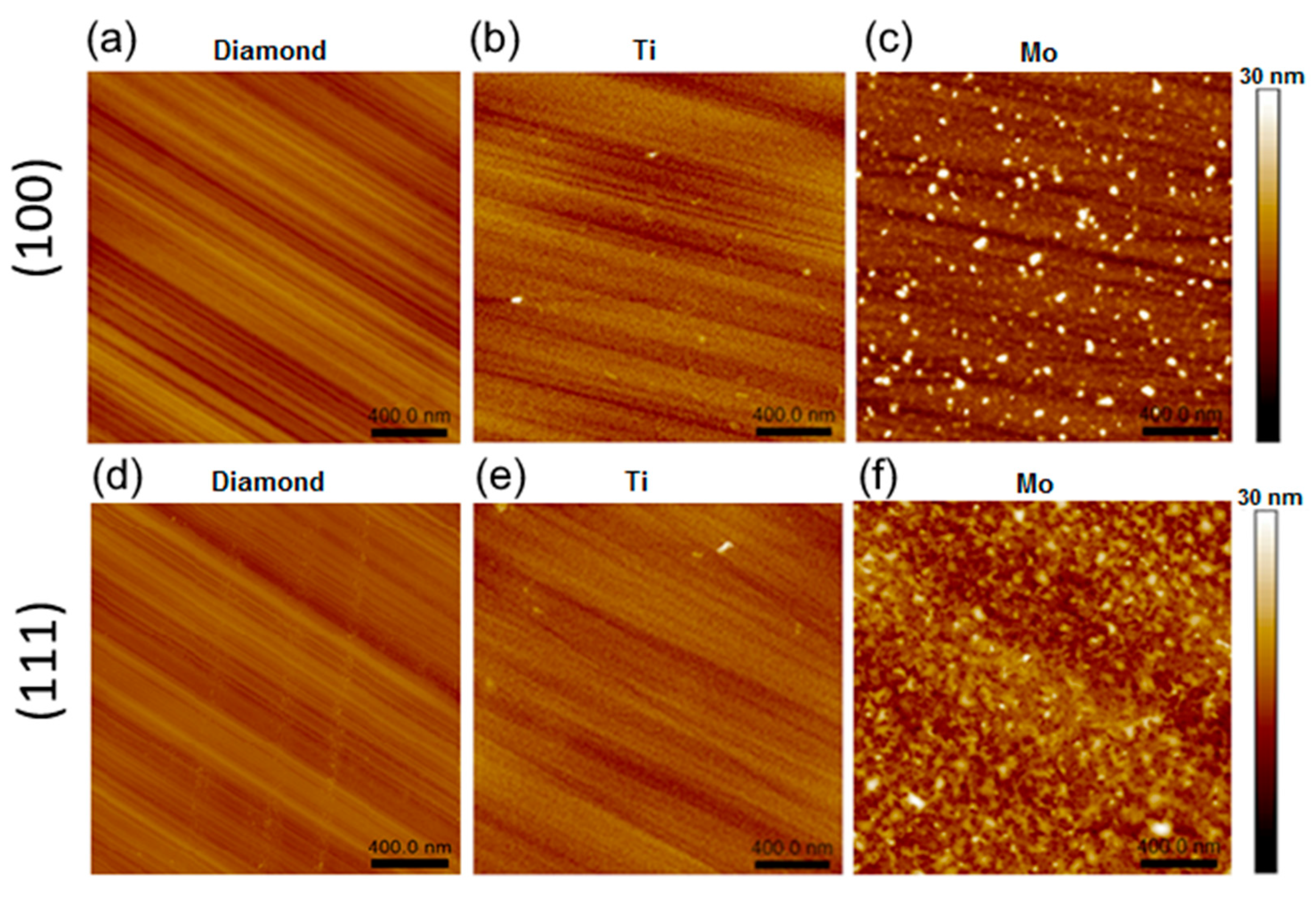

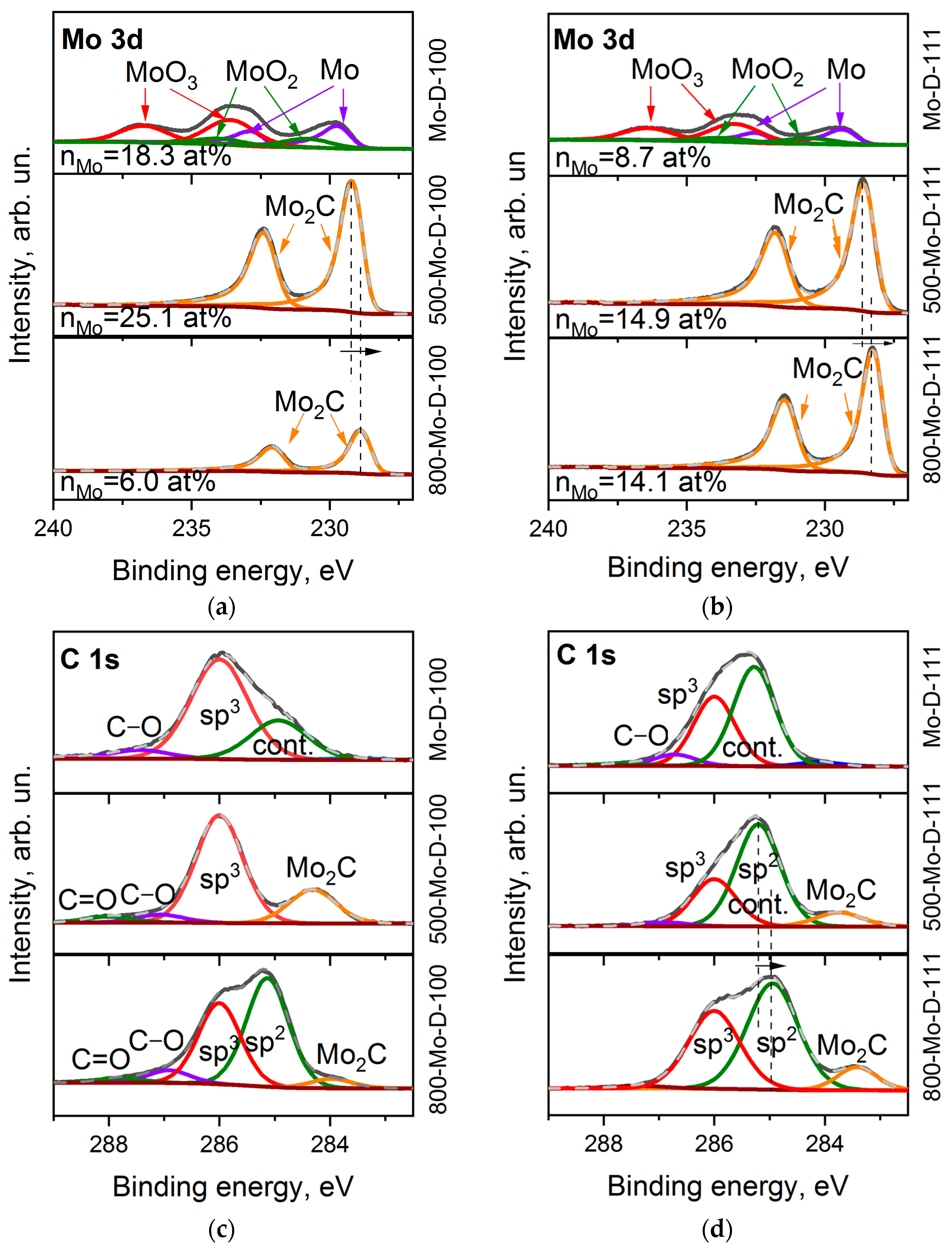
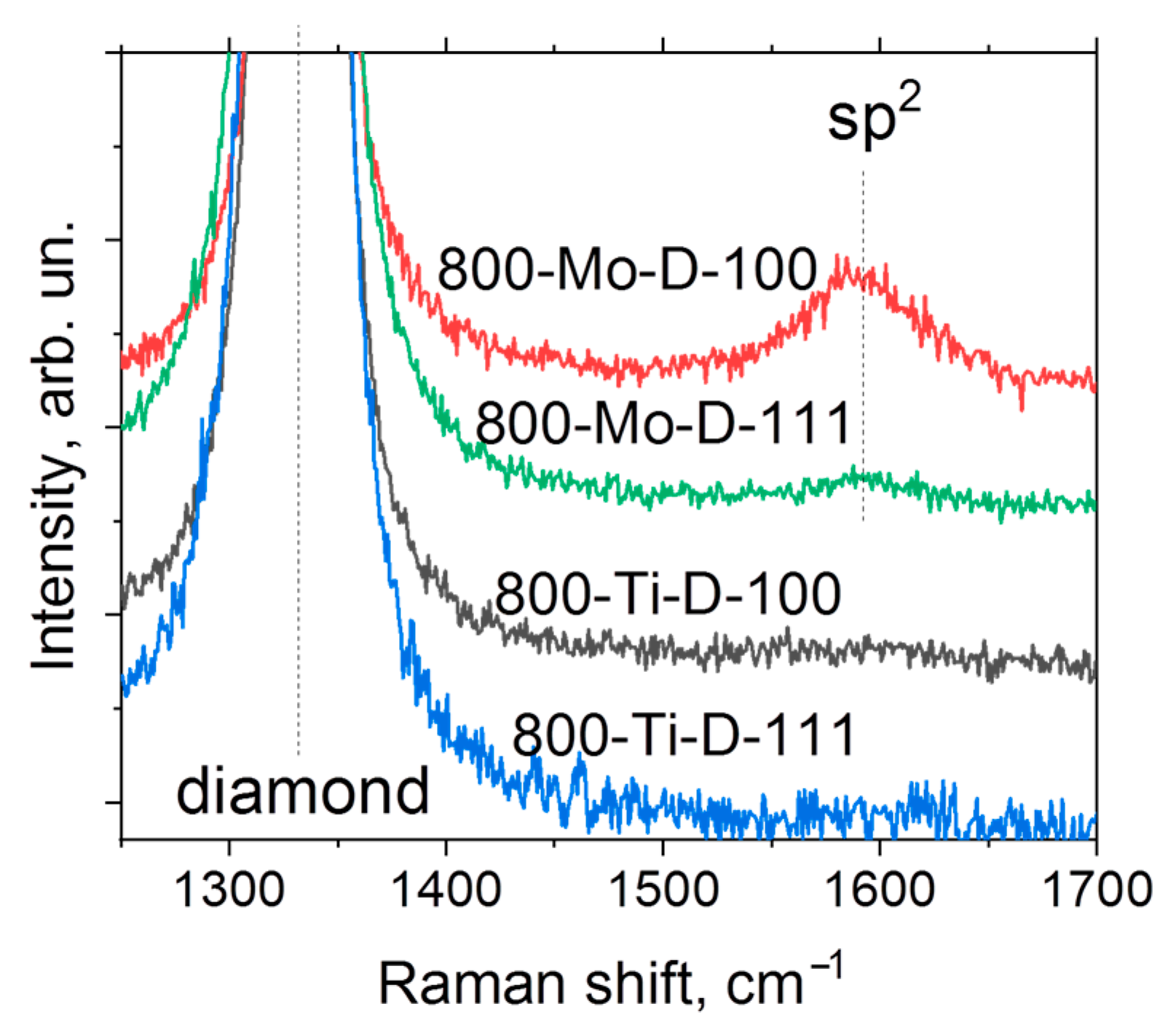
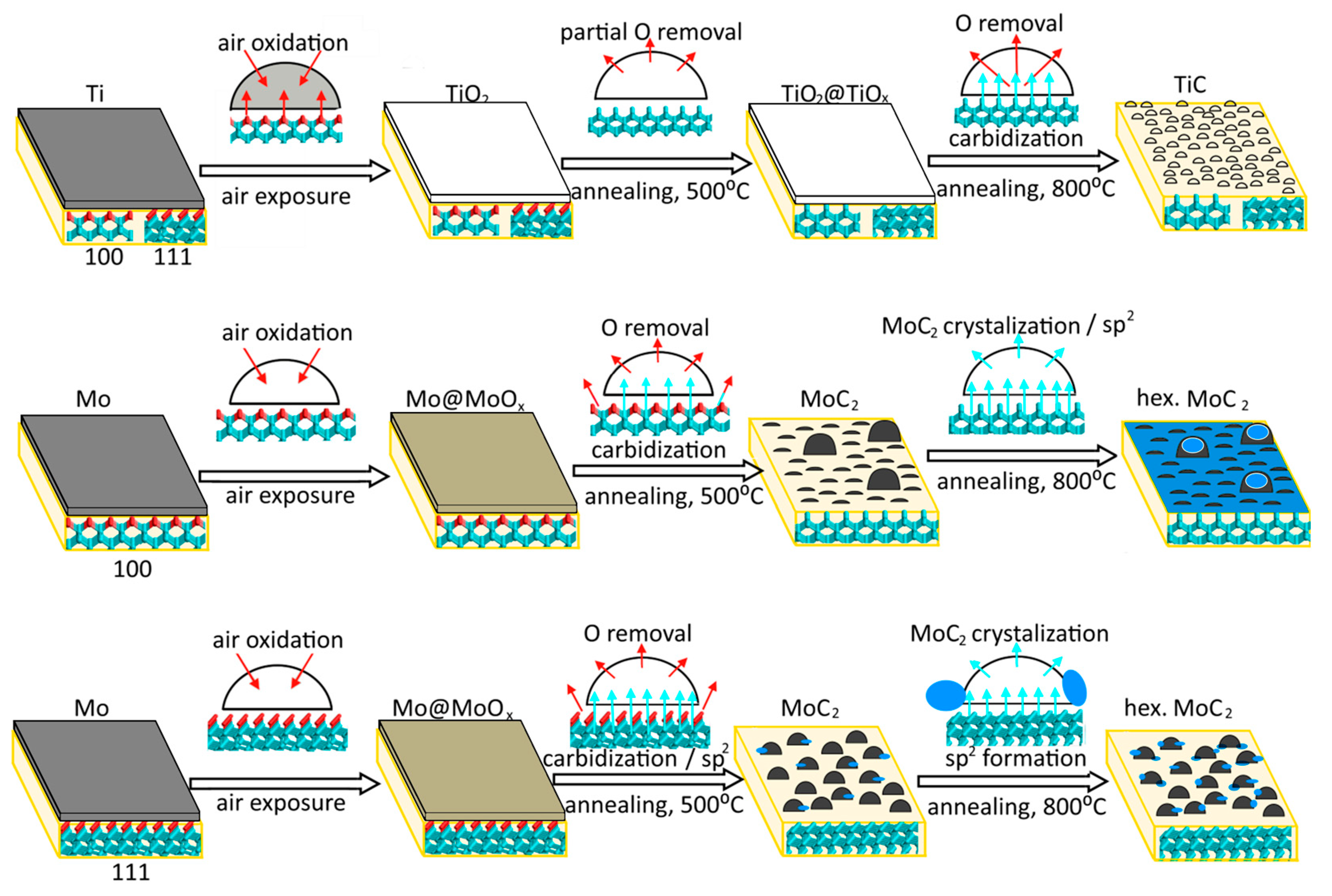
| Sample | Element Concentration, at.% | Sample | Element Concentration, at.% | ||||||
|---|---|---|---|---|---|---|---|---|---|
| nC | nO | nTi | nMo | nC | nO | nTi | nMo | ||
| D-100 | 97.2 | 2.8 | - | - | D-111 | 95.7 | 4.1 | 0.2 | - |
| 500-D-100 | 99.8 | 0.2 | - | - | 500-D-111 | 99.3 | 0.6 | - | 0.1 |
| 800-D-100 | 100.0 | 0.0 | - | - | 800-D-111 | 99.7 | 0.2 | - | 0.1 |
| Ti-D-100 | 74.3 | 20.0 | 6.7 | - | Ti-D-111 | 81.8 | 14.2 | 4.0 | - |
| 500-Ti-D-100 | 84.9 | 10.4 | 4.7 | - | 500-Ti-D-111 | 85.9 | 9.8 | 4.3 | - |
| 800-Ti-D-100 | 93.7 | 0.3 | 6.1 | - | 800-Ti-D-111 | 94.8 | 0.7 | 4.4 | - |
| Mo-D-100 | 49.8 | 31.3 | - | 18.3 | Mo-D-111 | 75.7 | 15.6 | - | 8.7 |
| 500-Mo-D-100 | 73.7 | 1.2 | - | 25.1 | 500-Mo-D-111 | 82.4 | 2.7 | - | 14.9 |
| 800-Mo-D-100 | 93.9 | 0.1 | - | 6.0 | 800-Mo-D-111 | 85.9 | 0.0 | - | 14.1 |
Disclaimer/Publisher’s Note: The statements, opinions and data contained in all publications are solely those of the individual author(s) and contributor(s) and not of MDPI and/or the editor(s). MDPI and/or the editor(s) disclaim responsibility for any injury to people or property resulting from any ideas, methods, instructions or products referred to in the content. |
© 2023 by the authors. Licensee MDPI, Basel, Switzerland. This article is an open access article distributed under the terms and conditions of the Creative Commons Attribution (CC BY) license (https://creativecommons.org/licenses/by/4.0/).
Share and Cite
Okotrub, A.V.; Sedelnikova, O.V.; Gorodetskiy, D.V.; Fedorenko, A.D.; Asanov, I.P.; Palyanov, Y.N.; Lapega, A.V.; Gurova, O.A.; Bulusheva, L.G. Effect of Titanium and Molybdenum Cover on the Surface Restructuration of Diamond Single Crystal during Annealing. Materials 2023, 16, 1650. https://doi.org/10.3390/ma16041650
Okotrub AV, Sedelnikova OV, Gorodetskiy DV, Fedorenko AD, Asanov IP, Palyanov YN, Lapega AV, Gurova OA, Bulusheva LG. Effect of Titanium and Molybdenum Cover on the Surface Restructuration of Diamond Single Crystal during Annealing. Materials. 2023; 16(4):1650. https://doi.org/10.3390/ma16041650
Chicago/Turabian StyleOkotrub, Alexander V., Olga V. Sedelnikova, Dmitriy V. Gorodetskiy, Anastasiya D. Fedorenko, Igor P. Asanov, Yury N. Palyanov, Alina V. Lapega, Olga A. Gurova, and Lyubov G. Bulusheva. 2023. "Effect of Titanium and Molybdenum Cover on the Surface Restructuration of Diamond Single Crystal during Annealing" Materials 16, no. 4: 1650. https://doi.org/10.3390/ma16041650
APA StyleOkotrub, A. V., Sedelnikova, O. V., Gorodetskiy, D. V., Fedorenko, A. D., Asanov, I. P., Palyanov, Y. N., Lapega, A. V., Gurova, O. A., & Bulusheva, L. G. (2023). Effect of Titanium and Molybdenum Cover on the Surface Restructuration of Diamond Single Crystal during Annealing. Materials, 16(4), 1650. https://doi.org/10.3390/ma16041650








